YouTube SEO fundamentals: What you need to know
YouTube says it's about the viewers, not algorithms. Uncover how to reconcile this with practical SEO tactics to grow your channel in 2025.
YouTube tells creators:
“Our algorithm doesn’t pay attention to videos; it pays attention to viewers. So, rather than trying to make videos that’ll make an algorithm happy, focus on making videos that make your viewers happy.”
But YouTube also shares these tips to optimize your video:
“You can optimize your videos to help viewers find your content easily and keep them engaged. Watch the video below for an intro to video thumbnails, titles, and descriptions. You’ll also learn about info cards, end screens, and playlists.”
How can YouTube SEOs reconcile this conflicting advice?
Maybe significantly more viewers discover new videos on their Home page and in their Shorts tab than through YouTube Search.
What YouTube tells creators is true – from a certain point of view.
This means “you must unlearn what you have learned” before discovering what you need to know about YouTube SEO today.
If you’re still using the same old step-by-step process to optimize YouTube videos that you learned five years ago, then “much to learn, you still have.”
So, what’s changed?
The answers to five key questions hold the key to understanding YouTube SEO’s evolution:
- Who?
- Seeks what?
- In which channel?
- From whom?
- With what effect?
Let’s uncover why YouTube SEO has shifted so dramatically in recent years.
Who are your target audiences?
For many years, YouTube was the red-headed stepchild in social media’s extended family.
You can see this by looking at the Pew Research Center’s Social Media Fact Sheet, updated on Nov. 13, 2024.
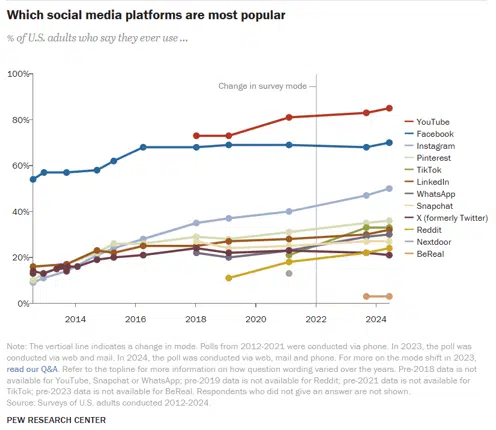
YouTube has been the most widely used online platform in the U.S. for at least seven years, with 85% of adults saying they use the platform.
By comparison, 70% use Facebook, 50% use Instagram, and 33% use TikTok.
When I show this data to digital marketers, who often make larger investments in Instagram and TikTok than YouTube, I hear the excuse: “We’re targeting a younger demographic.”
But Pew lets you drill deeper into the data to uncover that:
- 93% of Americans ages 18-29 use YouTube.
- By comparison, 76% use Instagram, 68% use Facebook, and 59% use TikTok.
Your audiences in the U.S. are using YouTube.
With over 2.5 billion monthly active users worldwide, YouTube is the most likely answer to this question in over 100 countries and 80 languages.
Besides, you already know “Why consumer intent is more powerful than demographics.”
As Lisa Gevelber explained on Think with Google:
“Marketers who rely only on demographics to reach consumers risk missing more than 70% of potential mobile shoppers. Why? Because demographics rarely tell the whole story. Understanding consumer intent is much more powerful.”
Understanding interests and affinity segments can also be more powerful than demographics.
What video content do they seek?
To answer this second question, check out “The latest YouTube stats on when, where, and what people watch” in the Consumer Insights section of Think with Google.
This section busts some common myths like: “YouTube is only for watching viral videos.”
What’s the reality these days?
People turn to YouTube for countless reasons:
- Learn something new.
- Have a good laugh.
- Stay up to date on the latest trends.
- Listen to music.
- Simply unwind with a show.
YouTube’s popularity as a video platform is undeniable.
Nearly four times as many people prefer watching videos on YouTube than less video-focused social media sites.
Viewers overwhelmingly cite relaxation and entertainment as their top two reasons when asked why they watch YouTube.
Comedy, music, entertainment/pop culture, and instructional (“how-to”) videos are the platform’s most popular content categories.
Significantly, 68% of YouTube users have used the platform to help them make purchasing decisions.
But the elephant in the room is YouTube Shorts.
Most YouTube users are gravitating toward short-form videos, originally limited to 60 seconds but can now be up to 3 minutes long.
Here’s the backstory:
- Shortly after TikTok was banned in India on June 29, 2020, YouTube launched the beta version of Shorts in India on Sept. 15, 2020.
- In March 2021, YouTube released Shorts in the U.S. on March 18, 2021, and rolled out Shorts globally on July 13, 2021.
Today, 2 billion people use YouTube Shorts monthly. Shorts are viewed over 70 billion times daily.
And according to Tubular Intelligence:
- In the last 365 days, 1.5 million accounts in the U.S. uploaded 167 million videos to YouTube, which got 6.2 trillion views and 205 billion engagements.
- Of this total, 1.1 million accounts uploaded 90.9 million Shorts, which got 5.1 trillion views and 180 billion engagements.
So, 54.4% of the YouTube videos uploaded in America last year were Shorts, and they got 82.3% of the views and 87.8% of the engagements. That’s a big one.
This doesn’t mean you should stop creating long-form content or using live streaming.
But it does mean that you should probably start creating more of the most popular type of YouTube Shorts content.
It’s entertainment, which includes challenges, pranks, and “oddly satisfying” videos.
These types of video content are popular because they are global-friendly and can be consumed in any language.
In which channels?
YouTube has multiple algorithms that work differently, including one for YouTube Shorts. That’s why “you must complete the training.”
YouTube is still the world’s second-largest search engine, behind only Google. Its ranking system considers these primary factors:
- Relevance: How closely a video’s title, description, and content align with a user’s query.
- Engagement: How many likes, comments, and shares a video gets.
Optimizing your metadata is still necessary, but it’s no longer sufficient.
YouTube’s other algorithms prioritize viewers over videos.
For example, YouTube’s recommendation system aims to show viewers Shorts they will likely enjoy.
By analyzing a viewer’s past behavior, YouTube’s search and discovery features tailor recommendations to individual interests.
This personalized approach encourages viewers to return to the platform regularly.
YouTube’s Home page welcomes viewers with a personalized video feed. This feed combines:
- Subscriptions: Videos from channels your audience has chosen to follow.
- Similar viewers: Videos that viewers with similar tastes have enjoyed.
- Fresh finds: New and exciting content based on YouTube’s understanding of your audience.
YouTube curates this selection using two key factors:
- Performance: How well videos have captivated and engaged similar viewers.
- Engagement history: How often your audience watches specific channels or topics, and how recently they’ve seen a particular video.
This approach also ensures viewers discover content relevant to their interests and keeps them coming back for more.
Up to 150 million people in the U.S. watch YouTube on connected TVs each month, more than 40% of the population.
Viewers can also discover YouTube videos embedded on websites and blogs, shared on social media platforms, and podcasts.
Considering all the channels viewers can use, creating content that resonates with your audience is the best strategy.
From whom?
The early goal of YouTube SEO was getting your video to “go viral.” Making videos worth watching and content worth sharing were the keys to success.
However, the 90.9 million Shorts uploaded in the last 365 days by U.S. accounts got 5.1 trillion views and 180 billion engagements, according to Tubular Intelligence’s data.
The average Short got 56,500 views and 2,200 engagements.
That’s not “going viral,” but it’s an engagement rate of 3.5%.
Of this total, 1.1 million influencers uploaded 85.3 million Shorts, which got 4.7 trillion views and 170 billion engagements.
By comparison, 73,200 brands uploaded 3.2 million Shorts, which got 177 billion views and 2,8 billion engagements.
Now that “watch history” and “interest in relevant topics” are elements of the success formula, you need to adopt YouTube’s updated goal as your own.
As their Search and discovery tips in YouTube Help clearly state:
- “The goal is to get people to watch more videos that they enjoy so they come back to YouTube regularly.”
If you can’t create video content your audience finds engaging and enjoyable enough to return for, consider collaborations to grow your channel and build your community.
With what effect?
The answer to the fifth question may cause YouTube SEOs anxiety, especially after they analyze The 2024 IAB Digital Video Ad Spend & Strategy Report, which states that “business outcomes are the most important KPI for buyers of digital video.”
- “The industry has bought, transacted, and measured against reach since the beginning of time,” said Cintia Gabilan, IAB’s VP of the Media Center, in a press release on July 16, 2024.
- She added, “But now business outcomes are the most important metrics to assess success, with reach and frequency coming in second.”
Why would YouTube SEOs have a bad feeling about this?
Because they know how to duel for resources with “Spaceballs,” which use metrics like reach and frequency. But facing “Sith Lords” who are using business outcomes as their KPIs can turn anxiety into fear.
So, “train yourself to let go of everything you fear to lose. Fear is the path to the dark side. Fear leads to anger. Anger leads to hate. Hate leads to suffering.”
To avoid this, you must go beyond reporting the number of views your channel received in the last 28 days. That’s a marketing output, not a business outcome.
Besides, all “views” are not created equal.
- On YouTube, a “view” is counted when a user watches a video for at least 30 seconds.
- On Instagram, a “view” is counted when a user watches a video for at least 3 seconds.
- And on TikTok, a “view” is counted immediately when a video starts playing.
This explains why so many digital marketers have mistakenly made larger investments in Instagram and TikTok than YouTube.
Going forward, you’ll need to adopt the same campaign objectives that your advertising colleagues are now using. They are:
- Awareness and consideration.
- Website traffic, leads, and sales.
Customer-centric approach to YouTube SEO
Now that you’ve unlearned what you learned, you’re ready to take a customer-centric approach to YouTube SEO.
“Customer centricity” is a business strategy that puts the customer at the center of a company’s philosophy, operations, and ideas.
It’s like “the Force, and a powerful ally it is.”
It involves anticipating a customer’s needs, wants, and communication preferences and then delivering on those expectations.
This can help build brand loyalty and lasting customer relationships.
A customer-centric approach also answers an updated set of five questions:
- Who?
- Discovers what?
- In which channel?
- From whom?
- With what effect?
Who: Audience research
The first step down this customer-centric path is conducting audience research to help you understand keywords or topics’ intent (e.g., needs, wants, and fears).
The best tool for this job is SparkToro. It provides a competitive advantage over other keyword research tools to craft more resonant, effective content.
For example, let’s say you’re the YouTube SEO for Visit Orlando.
SparkToro estimates that 4,000-5,000 people search for “visit Orlando” each month in the U.S.
As you can see below, 77% have an affinity for VisitOrlando.com.
They’re also searching for these keywords:
- “Best place for Thanksgiving dinner in Orlando.”
- “Restaurants west Orlando.”
- “Legoland Florida ticket.”
- “Things to do in Orlando besides theme parks.”
Finally, 53.5% are male, while 45.8% are female.
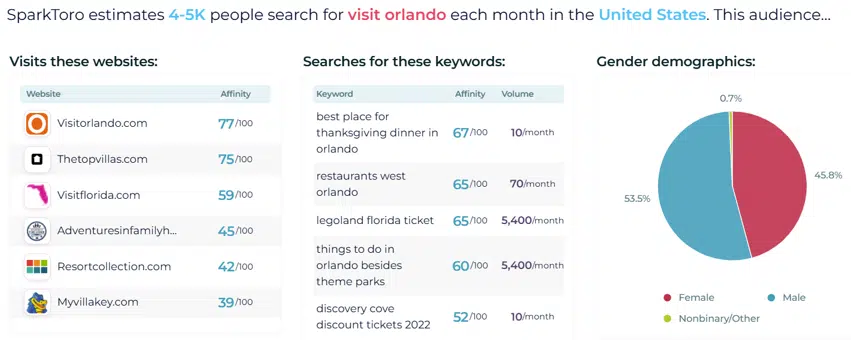
Or let’s say you’re the YouTube SEO for John Lewis & Partners, a British chain of high-end department stores.
SparkToro estimates that 3.5 million people visit JohnLewis.com globally each month.
As you can see below, 65% have an affinity for Argos.co.uk.
They’re searching for these keywords:
- “For wife Christmas gifts.”
“Freestanding boxing bag stand” - “Flight jacket women’s”
- “Funky tops.”
- “First gifts for girlfriend.
And 50.7% are male, while 48.9% are female.
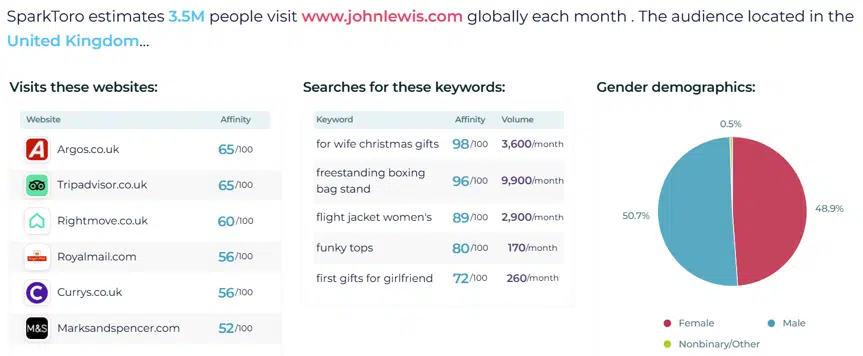
Or let’s say you’re the YouTube SEO for the Sharp Knife Shop, which markets Japanese knives, and you want to target Canadian chefs.
SparkToro found 35,000 accounts with “chef” in their bios located in Canada. As you can see below, 71% have an affinity for Canadas100Best.com.
They’re searching for these keywords:
- “Top restaurants Canada.”
- “Spot prawns Granville Island.”
- “Canada top 100 restaurants.”
- “Best restaurants on Granville Island.”
Oh, 73.5% are male, while 26.3% are female.
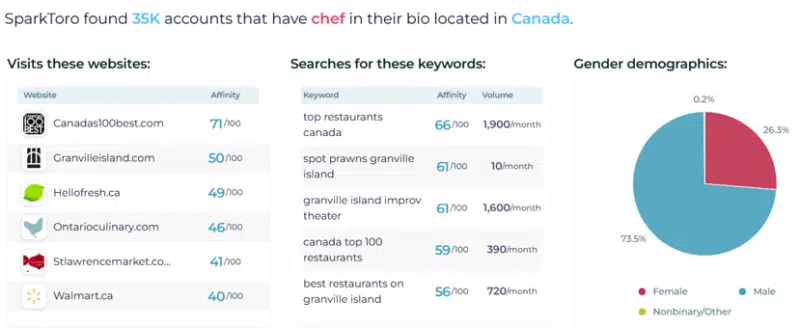
SparkToro helps you build data-driven personas with provable customer behaviors and demographics better than keyword research tools can.
Discovers what: Content optimization
The second step in a customer-centric approach is learning how to optimize video content for maximum effectiveness.
A recent development in this space is DAIVID’s AI-powered self-service platform, introduced in October 2024.
This tool analyzes millions of human ad responses to predict their emotional, attentional, and brand impact.
Providing second-by-second insights into how content resonates helps marketers identify key moments that enhance brand recall, sharing, and purchase intent.
Designed for scalability, the tool eliminates the need for traditional audience panels, offering instant feedback on ad performance.
It helps marketers quickly adapt their creative strategies to produce more impactful campaigns.
YouTube SEOs can also use the platform to optimize their content.
For example, you’d discover 55.5% of viewers experiencing intense positive emotions after watching “The Gifting Hour | John Lewis & Partners | Christmas Ad 2024,” making it the most emotionally engaging John Lewis Christmas ad in six years.
In which channel: Programming strategy
The “messy middle” of a customer-centric YouTube strategy involves developing a robust programming strategy that extends beyond a simple content calendar.
This strategy must account for the diverse ways viewers can discover Shorts on the platform.
While effective in the past, the traditional “help, hub, and hero” content model is insufficient for today’s YouTube landscape.
The rise of Shorts has fundamentally altered how viewers consume content, necessitating a new approach.
By understanding how viewers discover Shorts – whether through the feed, search results, homepage, channel pages, subscriptions, or notifications – you can tailor an effective programming strategy.
To effectively leverage Shorts, consider using this approach:
- Highlights
- Repurpose existing long-form content into engaging Shorts, extending their reach and potentially driving traffic back to the original video.
- This is a cost-effective way to maximize the value of your existing content library.
- Help
- Optimize your Shorts for discoverability by crafting compelling titles, descriptions, and eye-catching thumbnails.
- Tap into YouTube’s AI-powered Inspiration Tab to generate ideas, outlines, titles, and thumbnails.
- Use Gert Mellak’s “DESCRIBE framework for effective YouTube descriptions.”
- Utilize YouTube’s automatic captioning on long-form videos and Shorts.
- Hub
- Establish a consistent content schedule to keep your audience engaged and returning for more.
- Utilize end screens within your Shorts to promote other videos, encourage subscriptions, and guide viewers through your content ecosystem.
- By building a loyal following, you can increase the visibility of your future content.
- Homepage
- Personalize your channel’s Home tab to showcase your best work and direct viewers to the content that matters most.
- By strategically organizing your content, you can improve discoverability and drive engagement.
- Hype
- Leverage YouTube’s dedicated “Shorts” section to maximize the visibility of your short-form content.
- By optimizing your Shorts for this section, you can reach a wider audience and attract new viewers.
- Hero
- Continue to create high-quality, long-form content for significant events and product launches.
- Consider supplementing these efforts with a series of Shorts to build anticipation and generate excitement.
- By combining the power of long-form and short-form content, you can create a more impactful and engaging viewing experience.
By taking this multidimensional approach, you can navigate YouTube’s changes and make the most of your Shorts.
From whom: Evaluate options
The fourth step on this customer-centric path presents a fork in the road.
Creating great content is challenging, so many marketers turn to AI video generators or influencer marketing as shortcuts to engage viewers.
To explore one of these options, read “Evaluating 7 AI video generators while waiting for OpenAI’s Sora.”
Here are the key takeaways from the article.
Advantages of AI video generators
- Efficiency and speed: These tools can quickly generate videos, providing a solid foundation for further development.
- Ease of use: Many students found them user-friendly, requiring minimal technical expertise.
- Versatility: AI tools offer a wide range of customization options, including different languages and dialects.
Limitations and challenges of AI video generators
- Human oversight: AI-generated content often needs human review to ensure accuracy, cultural sensitivity, and emotional depth.
- Pronunciation and expression: AI voices, especially in non-native languages, may lack proper pronunciation and emotional nuance.
- Content originality: AI tools can struggle with generating truly original and creative content. Human creativity remains essential for adding unique elements.
If you take the other fork, you’ll quickly discover that the hardest part of influencer marketing is finding the right influencers.
Not all will add value to your brand, and some may use fake followers, so it’s crucial to verify the quality and engagement of their audience.
There are several tools that can help you find and vet influencers, including:
- HypeAuditor.
- Traackr.
- Tubular DealMaker.
You can also use SparkToro to identify high-affinity websites and sources of influence for your audience as well as YouTube channels, podcasts, and subreddits that your audience follows.
For example, searchers for “visit Orlando” in the U.S. are most likely to watch or subscribe to these YouTube channels:
- Top Villas.
- UndercoverTourist.com.
- VISIT FLORIDA.
- TUI UK.
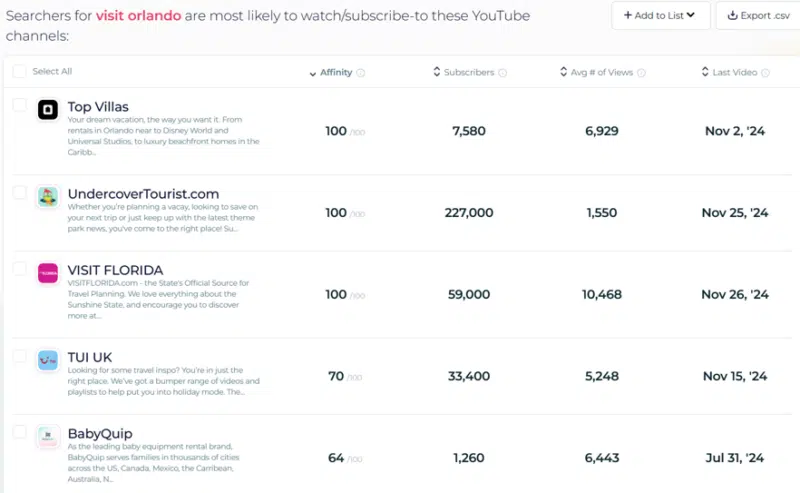
And these podcasts are likely to be listened to or subscribed to by people with “chef” in their profile in Canada:
- The Voice4Chefs Podcast.
- Recipe For A Good Day.
- What’s Cooking With Chef Noel.
- Raging And Eating.
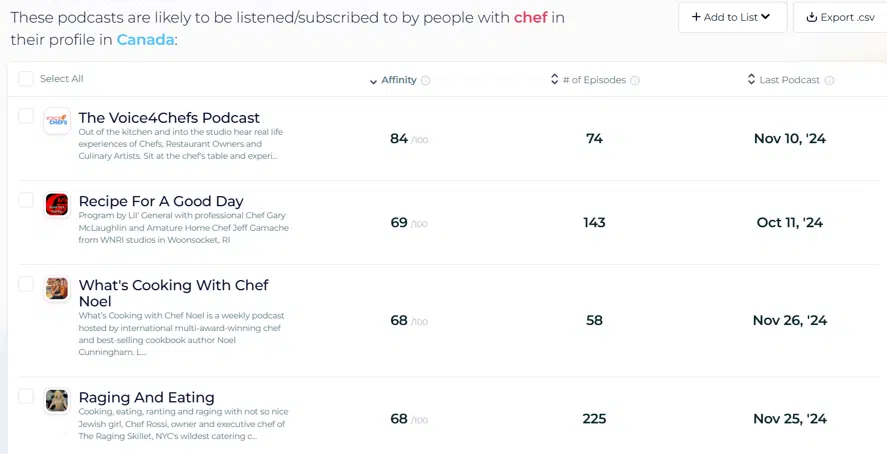
Advertisers can use YouTube BrandConnect, a self-service platform, to find the right creators, set up branded content marketing campaigns, and track their performance.
Whichever tool you select to find compatible collaborators and relevant influencers, “To be Jedi is to face the truth and choose.”
With what effect: Business outcomes
The last step in this customer-centric path is starting to measure business outcomes.
Now, different YouTube SEOs have different campaign objectives, so they’ll need new KPIs to measure:
- Awareness and consideration.
- Website traffic, leads, and sales.
How do you measure awareness and consideration?
Use a modified version of Brand Lift, a “free” tool for measuring the effectiveness of video ads.
Through surveys shown to groups of people at different times, Brand Lift studies can measure the effectiveness of your YouTube SEO campaign on:
- Brand awareness.
- Consideration.
- Favorability.
- Purchase intent.
You can also:
- Try Google Forms to create, share, and analyze your surveys.
- Use Google Surveys to ask customized questions for 1¢ per response or $5.00 for 500 responses.
- Create “YouTube Community Posts” and choose to add polls.
So, how do you measure website traffic, leads, and sales?
Start by reading “How to use GA4 to optimize your digital marketing strategy.”
GA4’s metric, engaged-view conversions (EVCs), tracks conversions from users who watched a YouTube ad for at least 10 seconds and then convert on the advertiser’s website within three days.
This aligns with consumer behavior: people often watch YouTube ads and may delay their purchase decisions until after their viewing session.
YouTube SEOs can use EVCs to explain why 68% of YouTube viewers ultimately make purchases after discovering brands on the platform.
Then, read “Why the shift from ‘conversions’ to ‘key events’ in GA4 is a game-changer.”
GA4 has a default channel for Organic Video, which tracks users who arrive via non-ad links on sites like YouTube.
But a substantial portion of traffic marked as “direct” in GA4 was likely sent by “dark social” networks.
That’s what you need to know about YouTube SEO today. The future?
“Difficult to see. Always in motion is the future.”
Contributing authors are invited to create content for Search Engine Land and are chosen for their expertise and contribution to the search community. Our contributors work under the oversight of the editorial staff and contributions are checked for quality and relevance to our readers. The opinions they express are their own.
Related stories
New on Search Engine Land

